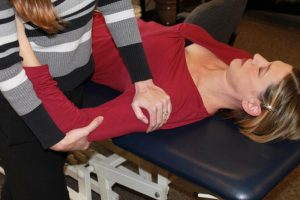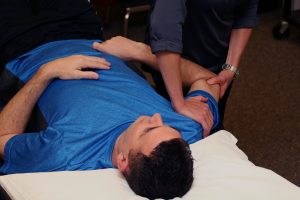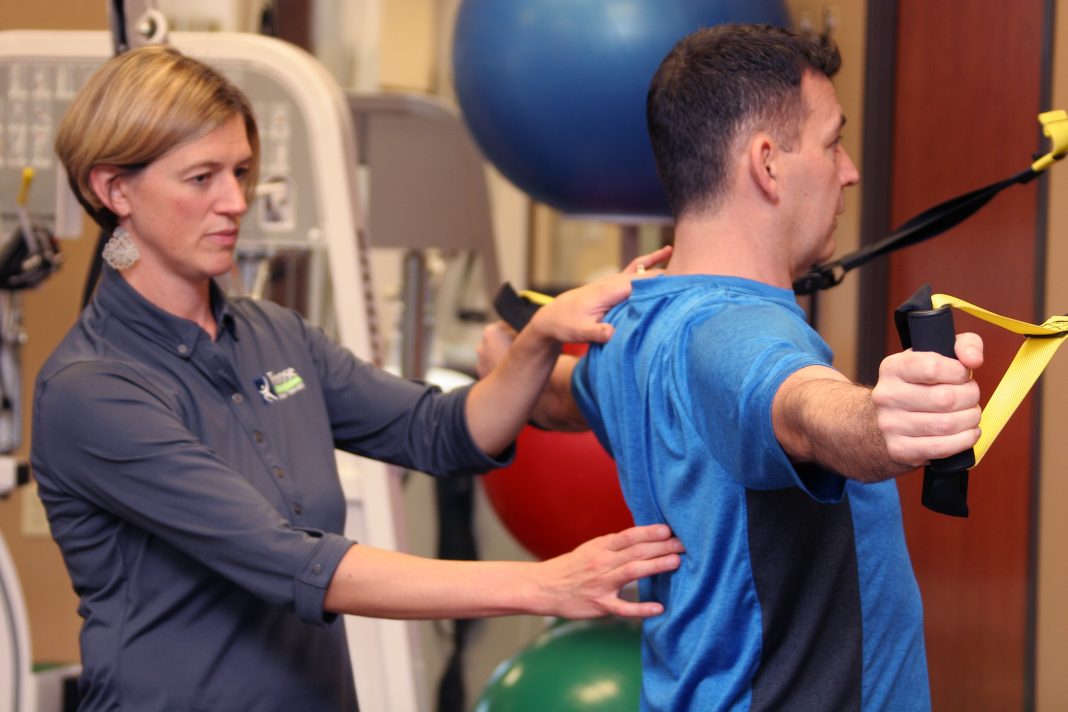Submitted by Dr. Jennifer Penrose of Penrose & Associates Physical Therapy
Pain is interesting. It doesn’t always tell us what caused the pain. And to make if even more complicated the onset of pain can be delayed by several days and even weeks from the initial injury. This can be super frustrating to figure out what is wrong, how to fix it, and how to prevent it from happening again.

Let me try to tell a common story about shoulder pain that seems to come from nowhere. Bill noticed a slight ache in the top side of his shoulder that steadily increased over the last few weeks. He didn’t recall doing anything that caused the pain. We chatted a little more and I asked about any arm activities in the last two months. He did say several weeks prior he had done a little more yardwork that required some overhead activity. He said it was fatiguing but didn’t notice any pain. This is a common history with shoulders. We do something a little more strenuous overhead that we don’t do on a regular basis and then a few days to a few weeks later we notice an ache that gets worse.
Why does this happen? The shoulder is a very mobile joint and it has approximately 18 muscles that influence the shoulder and shoulder blade. The shoulder joint has four key muscles that provide key shoulder stability at shoulder height and above called your rotator cuff. Unfortunately, the design of the rotator cuff has a poor blood supply to the tendon portion and this gets worse as we age. The tendon area is where people tear their rotator cuff. The tendon area of the rotator cuff often gets “pinched” in the shoulder when working at shoulder height or above. This pinch can happen for various reasons but it is most common when we are tight in certain areas of our chest and muscles that tend to pull our shoulders forward or our posture forward.
How does this happen? If you have developed some slouched posture and do not stretch and keep shoulder, thoracic spine (upper back), and chest mobility you will have limited range of motion in the shoulder creating an opportunity for “pinching” the tendon when working at shoulder height and above. Tightness can develop over time from lack of stretching and poor posture habits/prolonged computer use etc. Pinching can also come from bone spurs that develop from arthritis and this can be very tricky to manage if you also have tight posture muscles.
Back to explaining Bill’s story. Once we evaluated his movements, joint stiffness, muscle flexibility, strength and ruled out his pain was not coming from his neck (special orthopedic tests) we found he had tightness in the chest, thoracic spine, neck and shoulders. He needed some hands on mobilizations and release of the stiffness from us and then he was given ways to work on those at home without causing joint pain or worsening of symptoms. His medical diagnosis was “impingement” and “rotator cuff strain” but we outlined all the muscles involved and what he could do to fix it and prevent it from coming back.

I hope you can see that when you think you haven’t done anything lately you may need to go back in time AND really look at your posture, your flexibility, and understand the shoulder is often irritated easily from overhead activities. If you are interested in learning more about neck pain and shoulder pain we are hosting a free workshop likely in person and virtually.
The author, Jennifer Penrose, is a Doctor of Physical Therapy and owner of Penrose Physical Therapy. If you have any questions you can call 360-456-1444 or by email at info@penrosept.com.
We are located 3 miles from Jubilee Lodge across from Big 5 Sporting Goods and Walmart at 1445 Galaxy Dr. NE, Lacey. Visit the Penrose & Associates Physical Therapy website for more information.
More Resources
For those that may be walking and running more due to COVID and social distancing this book is must read! It is a number 1 release in walking for exercise and a number 1 release in pain management.
Dr. Penrose’s recent book “Run Forever. Secrets to common running and walking injuries” is available on kindle or paperwork via amazon and in her clinic. The book, which is an Amazon bestseller, covers knee pain, back pain, plantar fasciitis and much more! It has practical tips and pictures of exercises and tells patient stories to make it an easy read to relate to.
The new episode of “Stay Healthy South Sound” – Dr. Penrose’s monthly podcast – is now live! In May she interviewed Christine Kulhawik, Licensed Acupuncturist and Certified Functional Nutritionist. She owns Watershed Wellness in Tumwater, WA and you can find them here on Facebook or visit them online at watershedwellnesscenter.com. Topics include benefits of acupuncture, who it’s for and how it works (including its connection to your immune health). Listen to it today at these links!





















































